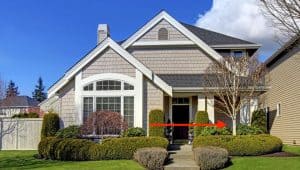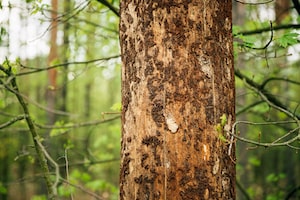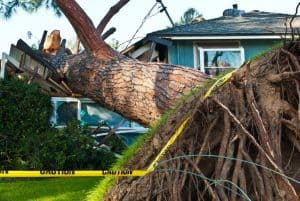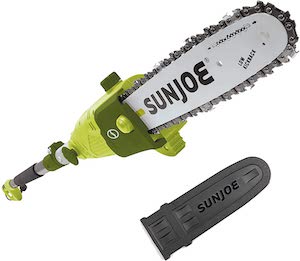If you are thinking about planting a new tree in your yard or deciding whether or not to take one down, then you should be able to find the answers to all of your questions here. It’s important to know just how close is too close when it comes to protecting your house from tree damage.
How far away should trees be from your house? As a general rule, trees should be planted anywhere from 10 to 20 feet (3 to 6 meters) away from your house. However, the final measurement depends on a number of factors, such as whether or not the tree is damaged or has shallow roots.
Trees can be a valuable asset to the value of your property when they are planted at a safe distance and maintained properly. Here is everything you need to know about trees as they relate to your home.
How close to a House Can you plant a tree?
The how and the where are important factors when deciding how close to place trees. Trees planted too close can damage house structures. A mature tree can also damage lawns, foundations, or driveways when its root system expands in search of water and nutrients. The distance between your house foundation and the tree trunk should depends on how large a tree you want to plant.
Small Tree Mature Height 10 feet: 10 to 15 feet (3-5 meters) Away from House
Medium Sized Tree Mature Height 15-20 feet: 15 to 20 feet (5-7 meters) Away from House
Large Tree Mature Height 20+ feet: 20+ feet (7+ meters) Away from House
Large Shrub Mature Diameter 20+ feet: 10+ feet Away from House
*These numbers represent minimum distances away from a house.
You may need more distance than this if your house is built on a slab foundation or if the land is prone to erosion or flooding. Similarly, how much distance you’ll need between driveway or sidewalk and the tree depends on how wide and how heavily traveled it is. When you plant a tree, you should also take into account how much space you will need under the tree canopy to maneuver a lawn mower and other yard care equipment. Large deciduous trees or evergreen trees will need space so you can gain access to branches in the event that they must be pruned or removed altogether. You will also want to provide enough room for the tree’s root system to expand.
How to determine if an existing tree is too close to your house
When you’re in the home real-estate market, mature shade trees can raise the market value of what you are selling or buying by up to $10,000.
They can also save a significant amount of energy. With a healthy fully grown shade tree sitting a safe distance away from your house, you can expect to reduce your heating and air conditioning bills by upwards of fifty percent. Trees can have incredible benefits on our environment.
However, there can also be a flip side to having trees around your home. Existing trees looming too close to your house can increase the risk of danger and property damage.
In order to avoid costly and dangerous problems in the future, it’s recommended that hazardous trees be removed. Once you’ve removed dangerous trees, you can plant new ones in their place.
Measure to get an Exact Distance
Make sure to measure to get an exact distance. Guessing can get you in trouble when trying to determine the distance of the tree from the house. Our go to tape measure here at Expert Home Report is the Stanley Fat Max Tape Measure. This tape measure is great for out door use. It won’t crumple up or get blown easy by the wind.
By doing this you have the potential to raise the market value of your home above its current status. So how exactly can you determine if you have a troublesome tree that should be removed?

Here is a tree that has been planted too close to the house.
Here are a few indicators that it’s time for a tree to be removed:
- Start with this simple formula. In an ideal situation, a tree will be planted with room to flourish. Therefore, the distance to the house should be no closer than half of its future full-grown length. For example, 20 feet may still be too close for some large species of trees that will grow beyond 40 feet tall.
- Trees growing 5 feet or less away from a house will almost always need to be removed.
- When branches scrape the sides or roof of a house it is probably because they are too close. Depending on the situation, you might be able to trim the problem limbs enough that full removal of the tree won’t be necessary.
Call an expert if you are unsure of whether or not a tree may cause damage by being too close to your house. Don’t make an assumption that a tree is safe if you aren’t 100% certain. It’s beneficial to have the area properly inspected in order to avoid the complications and risks of tree damage.
Other reasons for tree removal
Did you know that proximity isn’t the only cause for tree removal? There are many other reasons that it could be necessary to remove a tree. Keep an eye out for these red flags that may indicate a removal could be needed.
- The tree that used to be straight is now leaning
When a tree grows in a leaning position it doesn’t necessarily pose an immediate threat. However, when a tree begins to suddenly lean to the side, it could very well have serious structural problems.
- The trunk is damaged
Cracks and other damaged areas, such as a dying branch stub on a tree trunk, can indicate that there is internal decay going on. Trees can surprisingly survive for many years with undetected internal decay. However, it may only be a matter of time before decaying trees eventually fall and create damage. Another warning sign to look out for is a tree with multiple trunks. This scenario can create structural issues leading to a potential fall down the road.

- Hollow trees
A tree with a trunk that is hollowed out can be a dangerous hazard. This can happen from rotting or animals. If one third or more of the tree trunk is hollow on the inside, it will need to be removed as a precaution.
- Sprouts growing at the base of the tree
Epicormic shoots are sprouts that sometimes grow at the base of a tree that is in trouble. This is a sign of stress that should be evaluated by a professional.
- Trees growing beneath power lines
When a tree grows into power lines it will almost always need to be removed or else regularly pruned. When left unattended this becomes a potential safety hazard.
- Signs of sickness
You can check on the health of your tree by simply comparing it to other trees growing next to it. Thin leaf covering, yellowing or browning foliage and stunted growth are all telling signs that your tree might be having some trouble.
- Root defects
Root defects are often not as easily noticeable as other more evident issues. Watch for heaving soil and fungi growing around the tree’s base. These are common signs of a root problem. Whenever you suspect your tree is suffering from one or more of these issues, then reach out to the local tree expert to visit your property and assess the situation. A professional will be able to let you know whether or not your tree can be saved or if removal is a better option.

This tree was planted at good distance away from the house.
Are trees near your house dangerous?
Trees can be a hazard to buildings when they are planted too close. Their leaves may clog gutters, potentially causing ice dams or water penetration into the your home. Old, damaged or otherwise weak trees may fall on houses too which increases risk of injury especially if you live in an area where severe weather is prevalent during winter months such as snowstorms!
Trees are also used by insects and rodents to gain access into buildings where they may inadvertently spread insect infestations such as termites among other things. Falling branches from these same trees pose threats not only because of their weight but also due to communication lines they might topple on top off which could affect your phone service if you’re one who relies heavily upon it!
Keeping Your Home Safe
Tree removal is an extensive process. Phone an expert if you think this is a precaution you might need to take. In some cases, tree removal is not necessary.
If your tree happens to be very close to your house and a specialist deems it to not be a safety hazard, then they may recommend that you take other safety precautions such as tree trimming.
Tree trimming can be a simple process but it requires extreme knowledge and care. If you have experience with trees then you may be able to do yourself at home with the proper tools.
Otherwise, it’s best to get the help of a certified professional. Trimming the branches of your tree when they begin to hang over your roof can prevent issues like roof leaks, loss of shingles and mold from falling debris.
Damaged trees during severe weather have totaled up to more than one billion dollars in property damage in the United States in a single year. It is important to administer the proper maintenance and care that your tree needs.
If a tree is planted in a neighboring yard that has grown to hang over or touch the roof of your house, then in most cases you have the right to trim the branches which cross over into your property. Have a conversation with your local officials as well as your neighbor to discuss possible solutions and to preserve the health of the tree.
If you want to plant a new tree in your yard, remember to take into account the total width and height the tree will reach when it is fully grown. Also, consider the area in which the roots will spread and avoid them inter-tangling with gas or plumbing lines.

This tree was close enough to damage the house when it fell.
What should you do if a tree has fallen onto your home?
In the event that a tree too close to your home has caused damaged or fallen onto your roof, most home insurance policies will assist with paying for the costs of repairs and tree removal.
A tree falling incident can be devastating. After ensuring the safety of everyone in the building, it is best to evacuate the area. Be sure to avoid reentering the house until the final repairs have been completed.
If power lines were pulled down during the fall, keep a safe distance and contact the power company. Also, get in contact with your local disaster restoration service provider. They can help you through the process of filing your claim and taking the steps towards the restoration of your property.
What happens if your tree falls onto your neighbor’s home?
If your tree was in good health and fell across property lines onto your neighbor’s house during a storm, then your neighbor’s home insurance should be able to assess and cover the damages. Unfortunately, if your tree was sick or dying, then it will be your responsibility to take care of the incident along with the help of your insurance company.
Trees can be an asset or a liability for the value of your home. For all of these reasons, be vigilant and keep a close eye on the health of your trees. Sometimes, a sick tree can be nursed and treated back to health. While at other times, it is better and safer to avoid the possibility of an accident and remove a tree that is either growing too close to your home or is dying.
Related Questions:
What should I do if a tree falls on my home?
In the event that a medium sized tree too close to your home has caused damaged or fallen onto your roof, most home insurance policies will assist with paying for the costs of repairs and tree removal.
What are some reasons I would remove a tree that’s close to my house?
Did you know that proximity isn’t the only cause for tree removal? There are many other reasons that it could be necessary to remove a tree that is leaning, damaged, hollow or has roots that are growing under the house.


